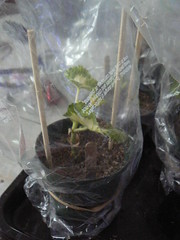
Today's frugal rainy-day gardening project: geranium cuttings! It's cheap and can be done indoors--perfect for our March-going-on-January weather. Here's what you need:
- A geranium plant that needs (or can tolerate) a trim
- Pots. I use old nursery pots, but you could also use yogurt cups, Dixie cups, or whatever you have around. Just remember to poke some drainage holes in the bottom.
- Vermiculite. The best thing I've found for rooting cuttings, vermiculite is available at your local garden center. Some people use plain ol' potting soil, but my results improved drastically when I listened to one of my horti-friends and started using vermiculite.
- Rooting hormone. Also available at your local garden center. It'll probably set you back about $8, but you'll have enough for hundreds of cuttings. Some gardeners have good luck without it, so feel free to skip it if you wish.
- Plastic bags
- Something to keep the plastic bag from touching your cutting--small stakes, chopsticks, plastic forks, etc.
- Rubber bands
- A waterproof tray
- Some kind of label
- A source of bottom heat. Optional but will improve your results. I put mine on top of my reef tank, where the lights keep the soil at about 80 degrees during the day. If you don't have a reef tank, don't buy one just for rooting cuttings--that would make this a distinctly unfrugal project. Try the top of your refrigerator, fork over for a heat mat (about $40 but reusable many times), scavenge an old waterbed heater, or do without the bottom heat.
Here's what to do:
- Fill pot(s) with vermiculite and wet it down till it's moist throughout.
- Take your cutting(s). Snip them just below a leaf bud, remove all but the top 2 or 3 leaves, and pinch off any flower buds or blossoms. You want your cutting to put its energy into roots, not flowers, and you don't want it to lose too much moisture through its leaves.
- Pour some rooting hormone into a shallow dish. Wet the bottom inch or so of your cutting and roll it in the rooting powder. Tap off the excess.
- Make a hole in the wet vermiculite and stick the cutting in at least an inch or two. Firm the vermiculite around the cutting. Repeat with additional cuttings if you wish to put more than one in a pot.
- Put a plastic bag over the cutting securing it around the bottom of the pot with a rubber band. Poke some holes in the plastic bag to control buildup of moisture.
- Put the pot on a waterproof tray, preferably one that can hold some water so you can water your cutting from the bottom when the vermiculite starts to dry out.
- Put the cuttings and tray on your source of bottom heat.
- Check your cuttings every few days and dispose of any that are wilted or rotting. Make sure the vermiculite is damp, watering from the bottom if it isn't.
- After a couple of weeks, or if you see new growth on your cutting, tug gently on it. If you feel resistance, you have roots! Pot the cutting in potting soil and care for it as you would any young geranium.
For my project, shown in the photo above, I used an old pot I'd saved from a plant purchased ages ago, an old produce bag, a rubber band from the newspaper, a popsicle stick for a label, and chopsticks from a long-ago Chinese takeout night, plus a cutting from a geranium I bought for a couple dollars at an estate sale last year. The only things that cost any money were the rooting powder and the vermiculite. I love projects that are cheap and fun!


No comments:
Post a Comment